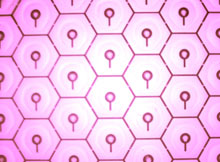A New E-Paper Competitor
A new display technology could make electronic paper look more like the real thing. Conventional ink on paper has a much higher brightness and black-and-white color contrast than electronic paper. The new display, made by researchers at the University of Cincinnati, in Ohio, is designed to match the brilliance and contrast of paper. “We’ve demonstrated a technology where you have the brightness of paper, and color has the same saturation that you expect from printed media,” says electrical- and computer-engineering professor Jason Heikenfeld, who led the work, which was published in Nature Photonics.

The pixels also switch between black and white within one millisecond, making the technology suitable for video (LCDs currently switch in a few milliseconds). A slower refresh speed of tens to hundreds of milliseconds is one of the main issues plaguing current e-paper.
So far, Heikenfeld and his colleagues have made rigid black-and-white displays that reflect 55 percent of ambient light–far more than any electronic-paper products currently on the market. White paper reflects 85 percent of ambient light, so it looks much brighter than Heikenfeld’s system. But Heikenfeld says that the technology could be used to make full-color flexible plastic displays that have more than 60 percent brilliance, and higher-grade materials and manufacturing processes should eventually make his device almost as bright as white paper.
The researchers plan to develop products through the startup Gamma Dynamics. Flexible pocket e-reader maker Polymer Vision of Eindhoven, the Netherlands, and pigments supplier Sun Chemical of Cincinnati are already partnering to commercialize the technology. “This technology has the potential to beat all electronic-paper technologies out there on a combination of an extremely high reflectivity; a high, video-capable switching speed; and a thin stack,” says Edzer Huitema, chief technology officer at Polymer Vision.
The new design offers the same advantage over LCDs as e-paper devices such as the Sony Reader and the Amazon Kindle. These devices, based on E Ink’s technology, reflect light instead of emitting it, making them easier to view in bright sunlight and more power efficient than LCDs. But they have a brightness of 35 to 40 percent, leading to a lower contrast ratio than printed paper. “Low power is great, but you have to look good … if you really want to compete with LCDs,” Heikenfeld says.
In their pixels, the researchers use aluminum layers that reflect light and carbon black ink for a deep black color. First, a polymer layer is patterned with wells that contain the black ink. An aluminum film is deposited on the polymer and topped with an indium tin oxide (ITO) transparent electrode layer. A voltage applied across the aluminum and the ITO electrode pulls the ink out of the well and spreads it over the entire pixel area.
The pixels are as small as 100 micrometers wide, giving the display a resolution of 300 dots per inch. This is higher than many e-readers on the market, Heikenfeld says. Putting red, green, and blue color filters on top of each pixel would create color displays.
Many other e-paper technologies are now emerging from corporate research labs and startups. Qualcomm’s MEMS-based pixels are now seen in cell-phone displays. Microsoft Research has made telescopic pixels that reflect or block light using a pair of mirrors. Fujitsu is making an e-reader based on Kent, OH’s Kent Display’s low-power LCD-like technology. University of Toronto spinoff Opalux, meanwhile, is making prototype color displays with photonic crystal pixels.
Keep Reading
Most Popular
Large language models can do jaw-dropping things. But nobody knows exactly why.
And that's a problem. Figuring it out is one of the biggest scientific puzzles of our time and a crucial step towards controlling more powerful future models.
How scientists traced a mysterious covid case back to six toilets
When wastewater surveillance turns into a hunt for a single infected individual, the ethics get tricky.
The problem with plug-in hybrids? Their drivers.
Plug-in hybrids are often sold as a transition to EVs, but new data from Europe shows we’re still underestimating the emissions they produce.
Google DeepMind’s new generative model makes Super Mario–like games from scratch
Genie learns how to control games by watching hours and hours of video. It could help train next-gen robots too.
Stay connected
Get the latest updates from
MIT Technology Review
Discover special offers, top stories, upcoming events, and more.